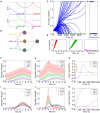The Role of Neuromodulators in Cortical Plasticity. A Computational Perspective
- PMID: 28119596
- PMCID: PMC5222801
- DOI: 10.3389/fnsyn.2016.00038
The Role of Neuromodulators in Cortical Plasticity. A Computational Perspective
Abstract
Neuromodulators play a ubiquitous role across the brain in regulating plasticity. With recent advances in experimental techniques, it is possible to study the effects of diverse neuromodulatory states in specific brain regions. Neuromodulators are thought to impact plasticity predominantly through two mechanisms: the gating of plasticity and the upregulation of neuronal activity. However, the consequences of these mechanisms are poorly understood and there is a need for both experimental and theoretical exploration. Here we illustrate how neuromodulatory state affects cortical plasticity through these two mechanisms. First, we explore the ability of neuromodulators to gate plasticity by reshaping the learning window for spike-timing-dependent plasticity. Using a simple computational model, we implement four different learning rules and demonstrate their effects on receptive field plasticity. We then compare the neuromodulatory effects of upregulating learning rate versus the effects of upregulating neuronal activity. We find that these seemingly similar mechanisms do not yield the same outcome: upregulating neuronal activity can lead to either a broadening or a sharpening of receptive field tuning, whereas upregulating learning rate only intensifies the sharpening of receptive field tuning. This simple model demonstrates the need for further exploration of the rich landscape of neuromodulator-mediated plasticity. Future experiments, coupled with biologically detailed computational models, will elucidate the diversity of mechanisms by which neuromodulatory state regulates cortical plasticity.
Keywords: acetylcholine; computational modeling; dopamine; neuromodulation; noradrenaline; synaptic plasticity.
Figures


Similar articles
-
Neuromodulated Spike-Timing-Dependent Plasticity, and Theory of Three-Factor Learning Rules.Front Neural Circuits. 2016 Jan 19;9:85. doi: 10.3389/fncir.2015.00085. eCollection 2015. Front Neural Circuits. 2016. PMID: 26834568 Free PMC article. Review.
-
Neuromodulators and Long-Term Synaptic Plasticity in Learning and Memory: A Steered-Glutamatergic Perspective.Brain Sci. 2019 Oct 31;9(11):300. doi: 10.3390/brainsci9110300. Brain Sci. 2019. PMID: 31683595 Free PMC article. Review.
-
Sequential neuromodulation of Hebbian plasticity offers mechanism for effective reward-based navigation.Elife. 2017 Jul 10;6:e27756. doi: 10.7554/eLife.27756. Elife. 2017. PMID: 28691903 Free PMC article.
-
Learning-induced physiological plasticity in the thalamo-cortical sensory systems: a critical evaluation of receptive field plasticity, map changes and their potential mechanisms.Prog Neurobiol. 1999 Feb;57(2):165-224. doi: 10.1016/s0301-0082(98)00042-2. Prog Neurobiol. 1999. PMID: 9987805 Review.
-
Astrocytes-The Ultimate Effectors of Long-Range Neuromodulatory Networks?Front Cell Neurosci. 2020 Sep 29;14:581075. doi: 10.3389/fncel.2020.581075. eCollection 2020. Front Cell Neurosci. 2020. PMID: 33192327 Free PMC article.
Cited by
-
Dendritic Excitability and Synaptic Plasticity In Vitro and In Vivo.Neuroscience. 2022 May 1;489:165-175. doi: 10.1016/j.neuroscience.2021.12.039. Epub 2022 Jan 5. Neuroscience. 2022. PMID: 34998890 Free PMC article. Review.
-
Contribution of Glutamatergic and GABAergic Mechanisms to the Plasticity-Modulating Effects of Dopamine in the Human Motor Cortex.Hum Brain Mapp. 2025 Feb 15;46(3):e70162. doi: 10.1002/hbm.70162. Hum Brain Mapp. 2025. PMID: 39945316 Free PMC article. Clinical Trial.
-
Astrocyte regulation of synaptic signaling in psychiatric disorders.Neuropsychopharmacology. 2023 Jan;48(1):21-36. doi: 10.1038/s41386-022-01338-w. Epub 2022 May 16. Neuropsychopharmacology. 2023. PMID: 35577914 Free PMC article. Review.
-
Exploring Neuromodulation for Dynamic Learning.Front Neurosci. 2020 Sep 18;14:928. doi: 10.3389/fnins.2020.00928. eCollection 2020. Front Neurosci. 2020. PMID: 33041754 Free PMC article.
-
Dendrites help mitigate the plasticity-stability dilemma.Sci Rep. 2023 Apr 21;13(1):6543. doi: 10.1038/s41598-023-32410-0. Sci Rep. 2023. PMID: 37085642 Free PMC article.
References
LinkOut - more resources
Full Text Sources
Other Literature Sources

